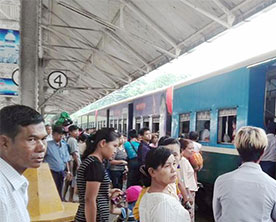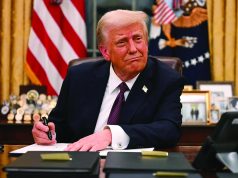One of the biggest problems, which Yangon is facing, is traffic jam. Except for Public Holidays, the residents of commercial hub suffer from traffic congestion on a daily basis.
According to motor.com.mm’s report which surveyed about 500 commuters in the commercial capital between late 2014 and early 2015, more than 33 percent of Yangon commuters who take buses spend four hours traveling to and from work every day.
To ease the traffic jam of Yangon, more and more people are taking Yangon Circular Train. To complement the YBS bus system, efforts have been made to upgrade the Yangon Circular Train.
Currently, statistics show 3.7 million, or 79 percent, of Yangon resident use buses for their daily commute, 7 percent catching ferries, 4 percent riding circle trains and 2 percent taking taxis.
As a part of the efforts to ease public transportation, Myanma Railways will start to upgrade Yangon circular railway in October 2017. The plan will be completed in 2022. During colonial times, Yangon Circular Railway was built by the British. The double track railway was built in 1954. In December 2012, Japan International C o o p e r a t i o n A g e n c y b e g a n i t s collaboration with Yangon City Development Committee to develop a master plan for the capital. JICA began conducting surveys to assist in creating the Myanmar’s National Transport Master Plan and the Project for Comprehensive Urban Transport Plan of the Greater Yangon (YUTRA). The Myanmar’s National Transport Master Plan sets a growth target of an average of 7.2 percent per year, taking into consideration the intentions of the Myanmar government.
If an annual average economic growth of 7.2 percent continues, the economy will be 5.4 times its current size by 2035. To achieve this growth, between 2014 and 2030, preliminary calculations show, some 2.67 trillion yen in investment is needed in basic transport infrastructure (which excludes urban and regional transportation) in all the fields of aviation, roads, rail, harbors and inland water transportation. The plan is to designate 2014 to 2020 as the emphasis period for improving basic transport infrastructure and to invest some 1.166 trillion yen over six years.
YUTRA projects that the current Yangon metropolitan area population of 5.7 million will be 9.7 million by 2035. The percentage of households owning automobiles is projected to rise from 12 percent to 32 percent and transportation demand is projected to be 1.8 times current levels.
The vision promulgated in the master plan is “to build a safe, comfortable and impartial transport system and a sustainable and efficient public transportation system in order to guarantee the mobility and accessibility of urban services needed by the people and society.”
While Government of Myanmar invests $94.76 million, under the direction of Japan International Cooperation Agency, it will be financed partly by $206 million (282.2 billion Kyats) assistance from Japan Official Development Assistance (ODA) loan.
Ba Myint, Project Manager said “the loan must be pay within 30 year after 10 years reprieve. The interest rate is just 0.01 percent. One thing, additionally, is the main contractors of the project must be a joint venture with Japan.”
Myanmar Railways is going to divide the track into two segments; eastern side and western side. Firstly, renovation of eastern side will start in October. On the eastern side, the first part (an 8.5 mile length from Danyigone to Paywetseikon station) is expected to complete by January 31, 2018. The second part (an 8.5 mile length from Paywetseikon to Pazundaung station) is expected to be completed by May 31, 2018. The renovation tasks on western side, the first part (a 3.75 mile length from Danyingone to Insein), the second part (a 5.5 mile length from Insein to Kyimyindaing station) and the third part (a 2.5 mile length from Kyimyindaing to Yangon would be completed by December 3, 2018, March 31, 2019, and May 31, 2019, respectively.
Htun Aung Thin, General Manager of Myanmar Railway, said “As part of the government’s effort to improve public transportation, the renovation task would include the purchase and installation of automatic signals as well as buying of new 66 DEMU carriages. The first batch of DEMU trains will arrive in Yangon in 2020.
He added “Rehabilitation of the station, bridges and platform will be implemented by government’s budget.” Currently, Yangon circular train is running 225 times per day, carrying over 90,000 commuters and take 2 hours and 50 minutes to finish 30 stations (28 mile). After renovation of Yangon circular train, around 2,400,000 commuters can enjoy the service with less than 2 hours round-about duration.










